13 Health Benefits of Makarasana & How to Do It?
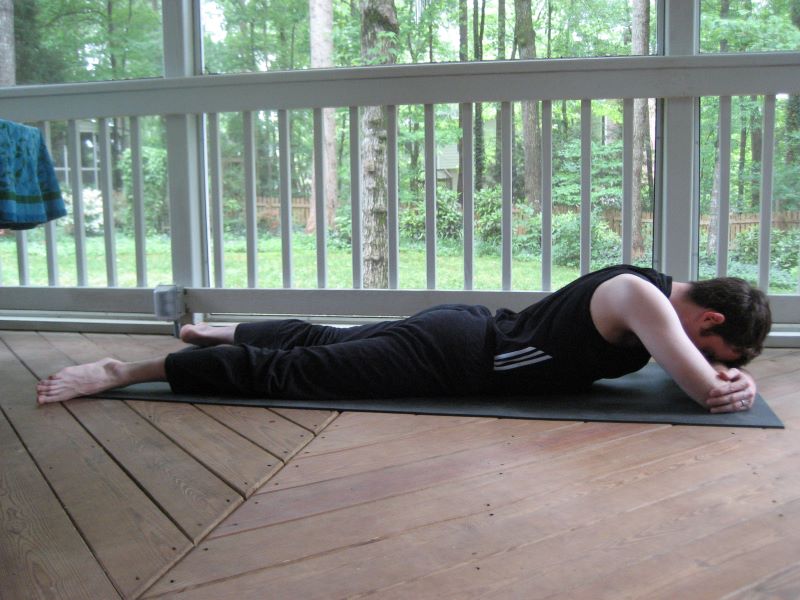
Makarasana (Crocodile Pose) is a vital posture ideal for asthma and lung diseases. This exercise can also relax the whole nervous system. Makarasana is made up of two words: “Makar” and “Asana,” where “Makar” means crocodile and “Asana” means posture.
Crocodile Pose reduces stress and tension in individuals who regularly practise it. It relaxes your muscles while calming your senses. Regardless, if you want to know about the health benefits of Makarasana, continue reading!

Table of Contents

What is Makarasana or Crocodile Pose?
Although the posture may seem simple, you must consider its various aspects. The posture got its name from Makara (crocodile), hence the name. This asana is a part of the hatha yoga style.
This posture can strengthen your shoulders, spine, arms, and chest. Those who suffer from severe spine-related problems must do this yoga. It will not only boost the stability of their spine but also improve their back flexibility.
We know there should be a gap of at least 3-4 hours after a meal to do any physical exercises. However, for the Crocodile Pose, it is unnecessary to do it on an empty stomach.
How to Perform Makarasana (Crocodile Pose)?
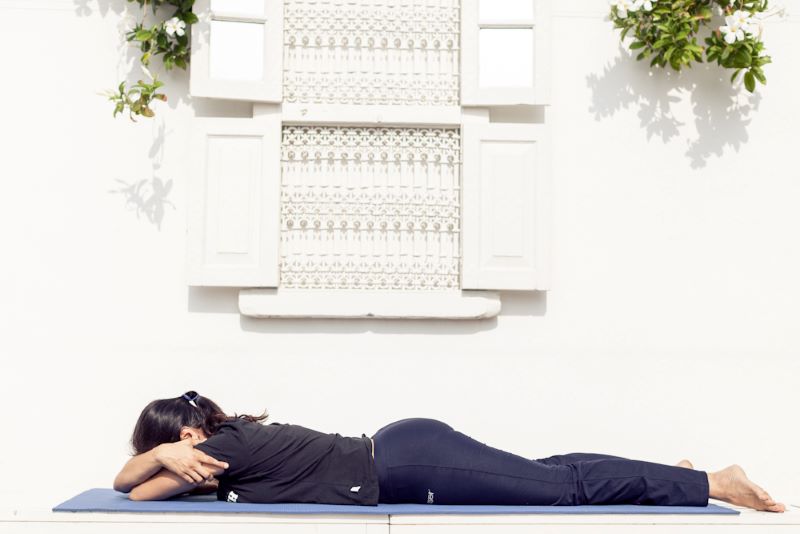
If you want to incorporate the Crocodile Pose, start with these preparatory poses. This will gradually ease your muscles so you can perform the Crocodile Pose without stiffness.
You can check out the following steps to learn the steps of doing Makarasana accurately:
Step 1: Sit on your knees, extend your arms to touch the mat and slowly put your legs behind you.
Step 2: Lower your legs and touch the yoga mat.
Step 3: Lower your hips, stomach and the rest of the upper portion on the mat.
Step 4: Cross your arms before you, forming a support to rest your forehead. The following steps are optional, but you can try them if you feel comfortable.
Step 5: Place your hands on the sides of your body and make your forehead touch the floor.
Step 6: Stretch your legs and straighten your spine.
Step 7: Release this pose and then carefully return to the first posture. To take the Crocodile Pose one step further, try doing this posture:
Step 8: Follow all the steps of Makarasana, but lift your upper body instead of resting your forehead.
Step 9: Hold the position and focus on stretching the body.
Step 10: Slowly lower your chest and return to the sitting posture.
13 Health Benefits of Makarasana
Makarasana is a restorative yoga posture that offers numerous health benefits. Here are some of the critical advantages of practising Makarasana:
1. Emphasises Contraction of Sacrum
The sacrum is a triangular bone at the base of the spinal cord, positioned between the two hip bones. Its function is to enable flexible hip movements. Practising the Crocodile Pose helps contract and relax the muscles around this bone, removing blockages and stimulating blood flow in the muscles around the spine.
2. Boosts Functioning of Abdominal Organs
Other essential benefits of Makarasana include boosting the functions of the abdominal organs. Breathing massages your abdominal area as you lie on your stomach in this yoga pose, ultimately helping organs like the spleen, urinary bladder, intestines, and other digestive organs work efficiently.
3. Relaxes the Respiratory System
When you lie down on your stomach, the need for oxygen and blood circulation in various parts of your body subsides. Hence, the respiratory and circulatory systems relax.
4. Relieves Tension From the Spine
To achieve perfection in Makarasana, you must stretch your shoulders and spine. This boosts flexibility and relieves tension in the spine. However, you should be mindful when doing this pose and remember it is for restoring the stretched muscles. That is why you should not exert any extra force.
5. Calms the Muscular System
When you correctly perform the crocodile posture, you experience a calmer entire muscular system. In addition, if you pay attention to the slower heartbeats, you may sense control over the body and mind.
6. Heals Anxiety and Insomnia
In this asana, you must eliminate all thoughts and channel your mind to breathing. Its principal function is to calm your nerves. Thus, it can heal anxiety and even cure insomnia.
7. Reduces Symptoms of PMS
Besides its other advantages, Makarasana especially helps women deal with the symptoms of menstruation. Moreover, abdominal massage benefits the reproductive organs and reduces PMS symptoms.
8. Strengthens the Core
While Makarasana may seem passive, it engages the core muscles, particularly the abdominals and lower back, helping to strengthen and tone these areas over time. A stronger core maintains abdominal health.
9. Alleviates Sciatica
Makarasana can help alleviate sciatica symptoms by gently stretching the sciatic nerve and reducing pressure on the lumbar spine. Makarasana also helps to stretch and relax the lower back muscles, reducing tension and alleviating pain in the lumbar region.
10. Promotes Mental Clarity
Practising Makarasana regularly can help clear the mind, improve focus, and enhance mental clarity by reducing mental fatigue and promoting relaxation. Performing the pose regularly offers a sense of calm.
11. Stimulates Blood Circulation
Makarasana stimulates blood flow throughout the body, promoting better circulation and delivering oxygen and nutrients to tissues and organs. It calms the circulatory system and allows for better blood flow.
12. Stretches the Chest and Shoulders
By opening up the chest and stretching the shoulders, Makarasana counteracts the effects of poor posture and sitting for extended periods, improving overall posture and shoulder flexibility.
13. Enhances Lung Capacity
The gentle expansion and contraction of the chest during Makarasana can improve lung function and increase lung capacity over time. Regularly performing the pose ensures a steady improvement in lung health.
The Mudras of Makarasana (Crocodile Pose)
Makarasana primarily focuses on relaxation and deep breathing rather than using specific mudras. Mudras often focus more on directing energy or enhancing concentration, which wouldn't be the primary goal in Makarasana. Although this is the only mudra that is naturally part of the Makarasana pose:
Makara Mudra
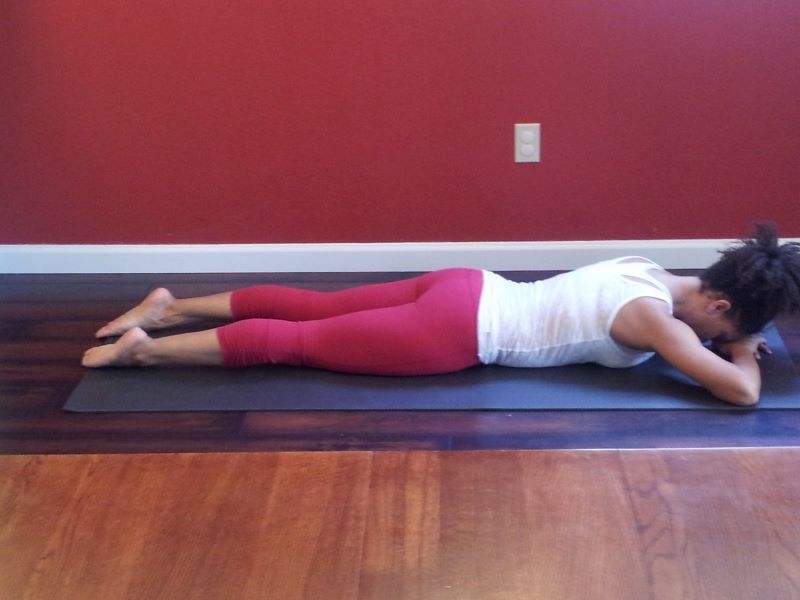
Makarasana, also known as the Crocodile Pose, incorporates Makara Mudra. This double-handed gesture involves placing one palm on the other to direct energy within the body.
Types of Makarasana
1. Upper Body Lift Makarasana

Begin by lying on your stomach with your legs extended behind you. Place your hands on the floor for support, and lift your body upwards. Your upper body up to the waist will be raised while the lower body will remain on the floor. This variation helps strengthen the muscles along the spine and improve posture.
2. Makarasana with Leg Lift
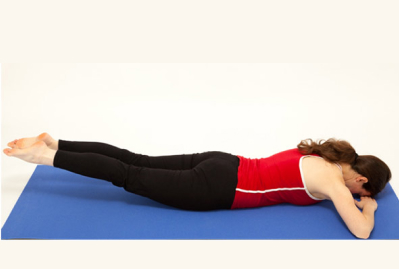
Start by lying on your stomach with your legs extended and your forehead resting on your stacked hands. Inhale and lift both your legs off the ground, keeping it straight. This variation strengthens the muscles in the back, glutes, and hamstrings while also engaging the core muscles.
3. Upper And Lower Body Lift Makarasana
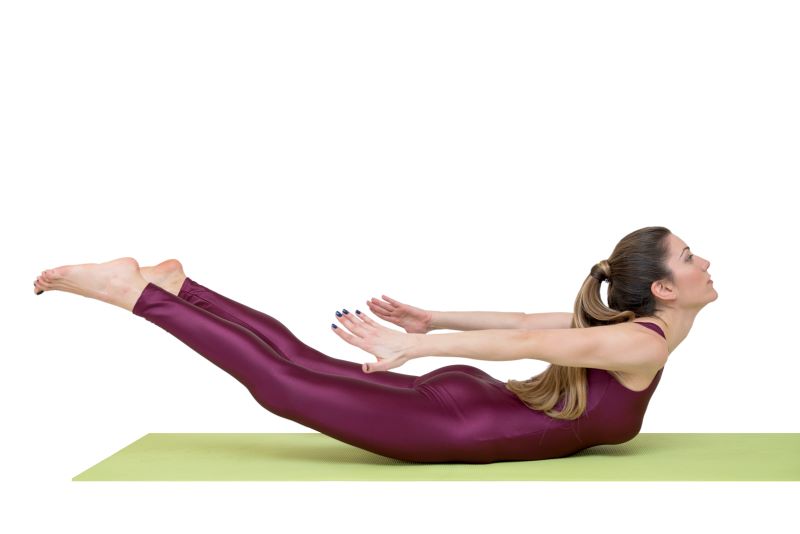
Lie on your stomach with your arms extended forward or backwards (per the difficulty level) and your legs stretched out. Simultaneously lift your upper body (head, chest, and arms) and lower body (legs) off the ground, engaging your core and back muscles. Hold the position for a few breaths, then gently lower and relax.
Things to Know Before Doing Makarasana Yoga
Makarasana requires some essential preparation before performing it. Here are some key points to know before doing Makarasana:
- Physical Preparation: Warm up with gentle stretches before attempting Makarasana to prevent injury and increase flexibility.
- Breath Awareness: Focus on your breath throughout the pose, inhaling deeply to expand the chest and exhaling fully to release tension.
- Proper Alignment: In the pose, align your body correctly, with your legs hip-width apart and arms extended forward, maintaining a straight spine.
- Neck Positioning: To avoid strain, keep your neck in a neutral position, neither straining it upwards nor letting it droop downwards.
- Gentle Compression: Allow the gentle compression of the abdomen against the floor to massage the internal organs and stimulate digestion.
- Relaxation: Makarasana is a relaxation pose, so focus on releasing tension from the body and mind, letting go of stress and worries.
- Duration: Start with holding the pose comfortably, gradually increasing the time as your flexibility and comfort level improve.
- Modifications: If you have any injuries or physical limitations, consider using props or modifying the pose to suit your body's needs and abilities.
- Awareness of Sensations: Pay attention to any sensations or discomfort in the body during the pose, and adjust or release the pose if needed to avoid strain.
- Breathing Technique: To enhance relaxation and stress relief, practise rhythmic breathing, inhaling deeply through the nose and exhaling fully through the mouth.
How Long to Hold Makarasana Pose?
The duration for any yoga asana varies depending on the expertise. Here's a guideline for how long to sit in Makarasana for practitioners at different levels:
- Beginners: Start by holding Makarasana for 1-2 minutes. Focus on maintaining proper alignment, breath awareness, and relaxation. Listen to your body and gradually increase the duration.
- Intermediate Level: Intermediate practitioners can aim to hold Makarasana for 3-5 minutes. By this stage, you should be familiar with the pose and able to maintain proper alignment and breath awareness for more extended periods.
- Advanced Level: Advanced practitioners can hold Makarasana for 5 minutes or longer, depending on their comfort level and practice goals. At this stage, you may have developed greater flexibility, strength, and mental focus.
With proper practice, a person can go from a beginner to an advanced level of practice. The key is practising correctly and respecting your body’s limits and needs.
Risks of Overdoing Makarasana
Indeed, there are several benefits to performing Makarasana. But here are the risks of overdoing Makarasana and not respecting your body’s limits:
- Neck Strain: Overdoing Makarasana can strain the neck muscles, especially if the head is lifted too high or held in an unnatural position for an extended period.
- Lower Back Discomfort: Excessive time spent in Makarasana can lead to discomfort or strain in the lower back, mainly if the pelvis is not adequately supported.
- Limited Circulation: Prolonged compression of the abdomen against the floor in Makarasana can restrict blood flow to the digestive organs, potentially causing digestive issues.
- Joint Discomfort: Overstretching or holding the pose for too long can put undue stress on the shoulder joints, elbows, wrists, and hips, leading to joint discomfort.
- Breathing Difficulty: Holding Makarasana for an extended period without proper support or alignment can restrict the ability to breathe deeply and comfortably.
- Increased Stress: Despite being a relaxation pose, overdoing Makarasana can paradoxically increase stress on the body if held for too long or if performed with improper alignment.
- Muscle Fatigue: Overuse of specific muscles in Makarasana, such as the back muscles and shoulders, without adequate rest or proper alignment, can lead to muscle fatigue.
- Excessive Pressure on Organs: Prolonged compression of the abdomen against the floor in Makarasana can exert undue pressure on the internal organs, disrupting normal organ function.
- Nerve Compression: Holding Makarasana for too long or improperly can compress nerves in the neck, back, or limbs, leading to numbness, tingling, or nerve pain over time.
- Decreased Flexibility: Overdoing Makarasana without proper alignment and moderation can reduce flexibility over time.
Listen to your body's signals regarding your limit. To get the maximum benefits, practice Makarasana according to your ability.
What are the Tips for Performing the Makarasana?
Crocodile Pose is one of the most accessible yoga poses, but you must do it right to get the benefits. Here are some tips for beginners on performing the Crocodile Pose:
If you struggle with balancing, use your hands to support yourself. Further, raise them to complete the posture.
Makarasana is a very relaxing pose; hence, one tends to fall asleep. Therefore, you should keep yourself awake while relaxing in this pose.
Some may feel conscious while lying in this pose, making them stiff. Avoid doing this because you aim to achieve complete muscle relaxation after a power-packed workout.
While waking up, make sure not to hurry.
As you need to stretch a little in this posture, remember not to over-stretch.
What are the Precautions and Contraindications of Makarasana?
Makarasana is the easiest yoga pose, and anyone can do it. Nevertheless, you should be aware of certain precautions and contraindications:
Prevent yourself from moving. Although this will not cause any physical harm, it will have a direct impact on your practice.
Never pressurise any body part because this is about relaxing your body and mind.
Try to avoid any disturbing atmosphere when doing the Crocodile Pose, as it can hamper your peace of mind.
Those with exaggerated lumbar curves must not try this posture.
As it requires lying on the stomach, it is not recommended for pregnant women.
Individuals suffering from stomach ailments must not do this posture.
Anyone who has higher blood pressure should also avoid doing this exercise.
Who Should Avoid Doing Makarasana?
With its many benefits, Makarasana can be beneficial for many people. However, specific individuals should avoid doing it:
- Recent Abdominal Surgery: Individuals who have undergone recent abdominal surgery should avoid Makarasana until they fully recover and receive clearance from their healthcare provider.
- Pregnant Women: Pregnant women, especially those in the second and third trimesters, should avoid lying on their stomachs, as this makes Makarasana unsuitable during pregnancy.
- Severe Back or Neck Injuries: Those with severe back or neck injuries should avoid Makarasana or any pose that involves lying on the stomach or putting pressure on the injured area unless under the guidance of a qualified yoga therapist or healthcare provider.
- High Blood Pressure: Individuals with uncontrolled high blood pressure should avoid prolonged holding of Makarasana, as it may affect blood pressure regulation.
- Glaucoma: People with glaucoma should avoid any pose that involves lying face down, including Makarasana, as it can increase intraocular pressure.
- Herniated Discs: Individuals with herniated discs or other spinal disc issues should exercise caution with Makarasana and avoid movements or positions that exacerbate their condition.
- Vertigo or Dizziness: Those who experience frequent episodes of vertigo or dizziness should avoid Makarasana, as lying face down may worsen these symptoms.
- Severe Respiratory Issues: Individuals with severe respiratory issues or breathing difficulties should avoid poses restricting chest expansion or deep breathing, such as Makarasana.
- Recent Injury: Anyone with a recent injury or acute pain in the neck, back, shoulders, or abdomen should avoid Makarasana until the injury has healed or until they receive clearance from a healthcare professional.
- Chronic Medical Conditions: Individuals with chronic medical conditions or other health concerns should consult a healthcare provider before attempting Makarasana or any new yoga practice to ensure safety.
What are the Easy Modifications of a Makarasana?

Some modifications of Makarasana include:
- Try to Do It With One Leg: Balance your body in this asana with one leg at a time. As you use the wall for support, slowly move the legs close to the chest and try to bring one leg up. Maintain the balance for some moment, and then use the other leg.
- Try Half-Headstand First: You can also go halfway and bend both knees. Then, bring your feet from the floor to keep your balance.
- Use a Cushion: Properly support your elbows, shoulders, and neck with cushions and foam to prevent injury.
So, now you know all about the benefits of Makarasana and the precautions you must take while performing it. However, do not try this if you suffer from injury or pain. Additionally, if you are feeling uncomfortable while performing Makarasana, avoid it. Finally, consult your trainer before modifying or starting this yoga pose.
Let's recap the entire piece: Makarasana is a restorative posture. It is mainly done after completing regular exercises to calm down the stretched muscles. If this yoga is practised accurately, you can extract many health benefits from It. So, the next time you do yoga, remember to end your session with the Crocodile Pose.













